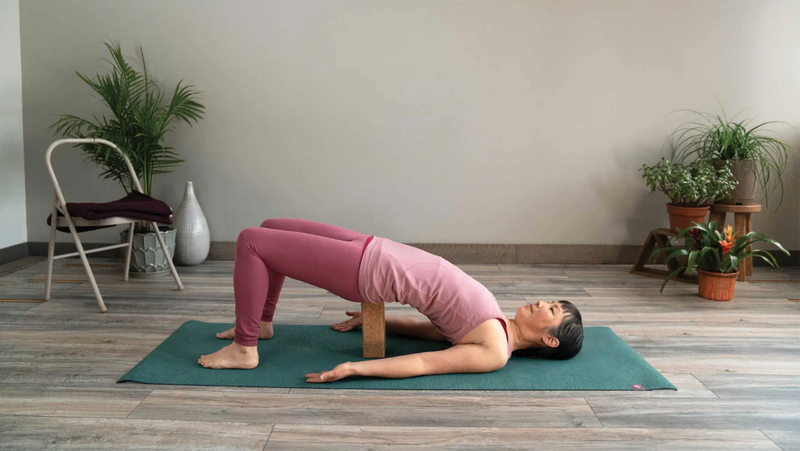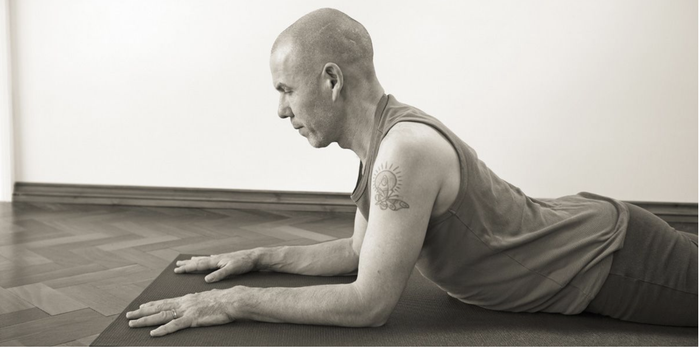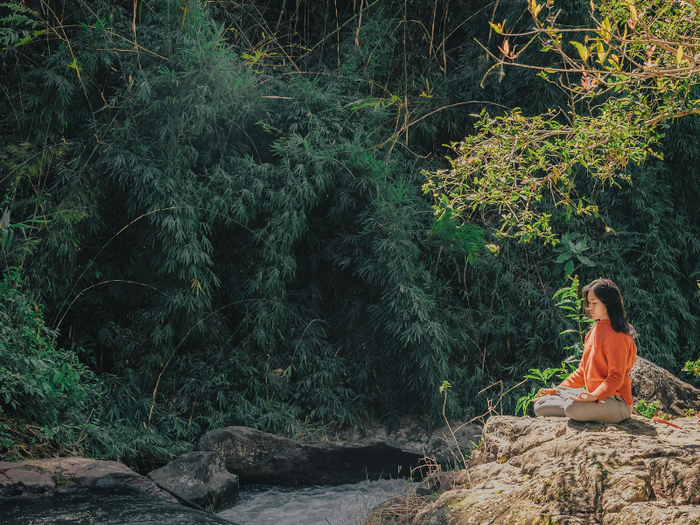When I train yoga teachers at the basic 200-hour level and in the specific Sleep Recovery method I’ve developed, I help them cultivate an acute awareness of how they set the tone for what students take away from class. After all, it makes a big difference in our students’ lives if they feel like they can relax and sleep peacefully after your practice—or if they’re awake all night.
Of course, we start by understanding and embodying the purpose of practices we teach; it also involves the pacing and tone of our own nervous systems as a model for our students. If teachers suffer from poor sleep (as I did), working on the roots of the problem, deep within our bodies and minds, can mean retooling some of the fundamental yoga practices and styles we’ve been doing for years. It can also be as simple as changing the time of day we practice.
At the same time, teachers without sleep issues can also be unaware that their sequences—while beautiful and uplifting—may be silently undermining a good night’s rest for the more delicate sleepers in the class. Here, I’ve pulled together a helpful guide to sleep-proofing your students’ (and perhaps your own) practice.
Sleep Saboteur: Too Hot, Too Late
Remember: they’re called Surya Namaskar (Sun Salutations) for a reason! The classical Mysore Ashtanga practice considers this warming flow a morning practice. Intense forward and backward bending are heating and stimulating—great to start your day, but not particularly suited to the time between evening and bedtime, when your nervous system and temperature need to start coming down.
When it comes to teaching yoga in the evenings, think of nervous system activation, heart rate intensity, and heat as a triple threat to sleep. Here’s why: You may know that our bodies, governed by circadian rhythms, initiate different hormonal, metabolic, neural, and nervous system functions depending on the time of day.
At night, we need to embrace ambient darkness in order to invite our sleep hormones to form and work their magic. Photoreceptors in our eyes send a message deep into our brains, converting serotonin, sometimes referred to as the happiness hormone, into sleep-inducing melatonin. When everything is functioning as it should be, our core body temperature comes down, and many positive hormonal feedback mechanisms take place, supporting our best sleep.
The fix: While the after-work hot yoga class or vinyasa flow may be great for some, if you or your students are finding sleep elusive, you’ll likely need to schedule these heating, heart rate-increasing practices for much earlier in the day—or avoid them entirely in favor of slower and steadier yoga.
Later in the evening, offer slow flows or static poses, with plenty of time to breathe with each movement. Add more cooling practices that slightly lengthen the exhale; or teach Chandra Bhedana Pranayama (Moon-Piercing Breath), a single-nostril breath associated with cooling, calming energy. Even if you begin with a heating practice and fast movements, cool it down at least about halfway through class to set your students up for relaxation.
"Try building more silence into your sequences. Breathe with your students. This can be the hardest thing for some yoga teachers, who may feel they need to keep giving something in order to be of value. Try offering silence, along with your expansive presence, not only will you cultivate your own ability to relax, but you will also empower your students to embrace moments of stillness and quiet - a skill they can lean on when it's time for bed."

Instead of a full Wheel Pose in the evening, try a supported Bridge Pose instead.
Sleep Saboteur: (Dramatically) Opening Your Heart
Sure, your students may need chest openers to counteract a day spent hunched over a laptop. But Urdvha Dhanurasana (Wheel Pose) and other extreme backbends that work against gravity and maintain shoulder blades deep into your back can keep students awake for hours afterward. In fact, breaking a sweat and a swift uptick in heart rate is a cue that the backbend may be stimulating the sympathetic (fight-or-flight activating) part of the autonomic nervous system.
I learned this the hard way through my students’ negative feedback: When I first started instructing, I chose to teach Dropbacks during a late-evening class; my regulars with sensitive sleep patterns reported they were up half the night. Bottom line: Backbends are great if you want to party, but not so helpful if you need to get some shuteye.
The fix: You can still include gentle chest-openers in an evening practice if your goal is to create more space for the breath or relieve tension from sitting all day. Stick to backbends like Setu Bandha Sarvangasana (Bridge Pose), in which the shoulder blades and the back of the head remain on the floor. This posture can easily increase breath circulation with far less heating and heart-pumping than Wheel.
Also, although Reverse Tabletop is slightly activating since you’re reaching yours arms back and keeping your legs strong, once you come out of the pose, it releases pent up energy from the arms and legs, leading to a sense of deep relaxation afterwards. The key difference is that the upper back is relatively level with your collarbones, knees, and hips in the same line. Try them both, yourself and in class, observing the changes you and your students experience, and inviting them to notice for themselves.
Sleep Saboteur: Kapalabhati
For some, the pumping breath of Kapalabhati (Skull-Shining Breath) is soothing at any time of day. However, for many folks, it’s simply too stimulating to the nervous system and counterproductive for a good night’s rest. If you must teach this practice in the evening, keep it short and indicate that—like orange juice or coffee–it’s enlivening and best suited for morning; share an alternative for students with sleep issues.
The fix: Offer a simple 1:2 or 2:4 breathing practice, gradually increasing the exhale until it’s twice as long as the inhale, which stimulates the parasympathetic (rest and digest) branch of the autonomic nervous system.
Sleep Saboteur: Spoiling Your Sleep Appetite
On the other side of the spectrum, we can also wreck our sleep appetite by taking too big a rest during the day. Sleep physicians often refer to the sleep drive, which is a measure of our biological need for sleep; in other words, the longer we are awake and expending effort, the more our desire to sleep builds up in various brain chemicals, including adenosine, a central nervous system depressant that decreases arousal and promotes sleep. Every hour we’re awake, the adenosine levels in the brain rise.
When we rest effectively, we decrease the adenosine and other tiredness neurotransmitters, and our S-drive goes down, making us less hungry for rest.
While a short meditation or restorative practice can be great ways to glide down into a calmer state before sleep, taking a full-length Restorative Yoga class or a long meditation later in the evening can set up conditions for you to fall asleep well before bedtime—eliminating your sleep appetite.
The fix: Try teaching longer restorative classes earlier in the day. Alternatively, you’re setting up a practice for a client, help them lace restoratives into their day in 10-20 minute pockets. This approach is especially useful alternative for students who tend to charge up their stress responses with exercise or caffeine. You’ll help them “put energy back on the grid” like a solar panel restores electricity—sustainably.
As for meditation, as the Transcendental and Vedic traditions suggest, keep it to the morning and late afternoon or early evening, ideally before dark or at twilight. If you love meditation before bed, make it a shorter practice so that you’re sure not to slip into pre-sleep sleep, and instead glide into the calmer and deeper brain wave patterns without taking away your sleep drive.
Sleep Saboteur: Over-Enthusiastic Ujjayi Breathing
The Ujjayi (Victorious) Breath many of us learned in Vinyasa Yoga is a heating practice, under the assumption that yoga’s power of transformation lay in tapasya, which means generating heat or energy. Practicing Ujjayi with a strong inhalation, constriction in the back of the throat, and a tendency to breathe into the upper chest add too much stimulation to an already-overheated nervous system.
In fact, if you do this for the duration of a 60- to 90-minute class, you’re stimulating the sympathetic nervous system (which activates your fight-or-flight response in extreme situations) the entire time.
The fix: Instead of cueing students to breathe into the upper chest with a strong inhale and strong exhale, you can actually modify Ujjayi so it supports sleep.
First, find the space between your shoulders and lower back, the area where your kidneys and adrenals sit. Imagine breathing into that space—down and back instead of up and front. For me, and for most people I’ve worked with, this has an immediate calming effect. Try this with your back supported by a chair, sofa, or wall to feel the support and feel your breath expand into that support.
Then, instead of lengthening the inhale, which sparks the sympathetic nervous system, even out the inhale and exhale, or start to lengthen the exhalation a bit.
Finally, refine your breath. Image it’s like a silken thread, very fine and subtle. Notice the muscles around your eyes and jaw, and allow them to relax. If there is any tension in your face and neck, imagine the back of your eyes and jaw gently release and become more spacious.
Sleep Saboteur: Setting a Rigid Breath Pace
Notice how you are bringing attention to the breath, breath counts, and pacing of the sequence in your classes. The constant attention on in, out, in, out with the breath can leave students with little time to settle in between inhales and exhales. Each student has their own tidal volume (lung capacity) and will therefore have their own optimal length of breath. Each person needs to find the individual pace that works best.
The fix: In order to fall asleep, we need to feel spacious in our bodies—and our breath can help us tap into this spaciousness. Ensure your breath pacing allows time for a billowing, settling-in state—a pause in between inhales and exhales.
Secondly, take a tip from John Stirk, renowned British teacher of 40 years and experience the power of the space after the exhalation. Once I experienced this for myself, I started imagining the exhale like gossamer silk dropping down from my hand to the floor slowly–and then settling for a moment. Try dropping into the space after the out-breath for a brief moment without moving, encouraging your body to land and settle, without any strain, before breathing in again.
Sleep Saboteur: Over-teaching
Teachers can inadvertently create an environment in which our collective nervous systems can’t settle down. It happens when we string one cue after the other in run-on sentences, with scant pauses between; it happens when we talk too quickly, or when we don’t slowly and deeply breathe with our students.
As a new yoga teacher, I remember feeling at first like I had to live up to the poetry and power of my own teachers, who said very eloquent things as they cued us through asana and integrated helpful alignment points. As a result, in my first couple of years of instructing, I talked nearly every second of all of my classes. Sure, they were vibrant and exciting, and they grew and flourished, but I was exhausted—and it wasn’t space where students could rest.
The fix: One of my mentors gave me wisdom that I now offer to my trainees: Pause after every cue; let it land; observe whether the students have heard and acted; then offer the next cue. In this space, I learned to breathe with them, and truly see the effect of my cues. In psychology, the principle of co-regulation says that the teacher has the power to set an inadvertently stressful pace—or the power to share the experience of the breath together and create a calming space.


